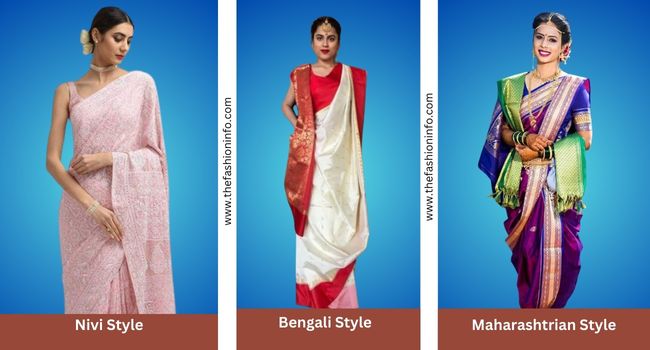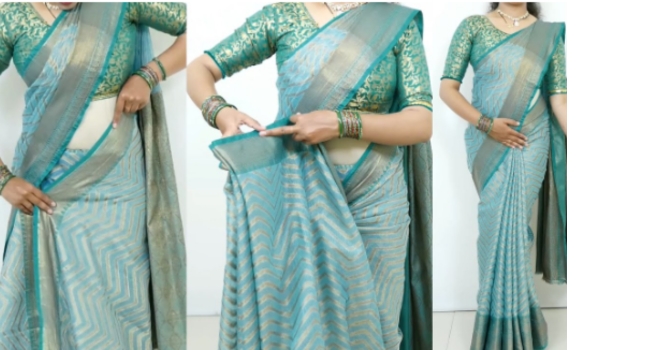Table of Contents
Introduction about Sarees and its Significance
Draping a saree, it is that traditional art form of South Asia, especially in India, where aesthetics and metaphorical outcomes come together. A saree is a piece of fabric that ranges between 6 to 9 yards long, elegantly drape around the body according to regions, a saree occasions, and personal preference. This self-evidently involves pleating the fabric and tucking into a petticoat with the loose end, pallu, draped over the shoulder.
Though there are several regional variations, such as Nivi style, Bengali style, or Maharashtrian style, in all these forms of draping, it brings a uniqueness of grace, tradition, and individuality to make it a timelessly iconic symbol of feminine beauty and pride.
Types of Saree draping
Saree draping varies a lot from region to region, with each style characteristic of the local traditions, climate, and values.
Of all these methods, Nivi is the most widely practiced in Andhra Pradesh, where it pleats the saree in the front and elegantly drape the pallu over the shoulder.
Contrasted with the Bengali style, it has a relatively loose drape with no pleats in the front and the pallu generally covers both shoulders. Maharashtrian style is similar to a dhoti where the saree is draped between the legs allowing ease of mobility and also is often related to traditional festivals.
Gujarati style-pallu is brought over the right shoulder from the back to the front. Coorgi drape, Karnataka: The pallu gets wrapped round the shoulder in an interesting knot from the front.
Mundum Neriyathum from Kerala: This is a two-piece saree with a simple and elegant way of draping. Each of these styles brings up the face that the saree is known not just for the utility but it, in fact, is an epitome of Indian culture.
Also Read: 20+ Amazing Saree Blouse Designs to Rock Your Ethnic Look
Different Saree Draping Images

How to Drape a Saree Step by Step
The traditional Nivi drape of the saree is something that can be simplified into easy tasks. Here’s how it goes:
Step 1: Preparation
- Wear the basics: Start by wearing a fitted blouse and an underskirt, or petticoat, of the same color as your saree. The petticoat, tied snugly at your waist with a drawstring, holds up the saree.
Step 2: Tucking the Saree
- You have to pick up the non-pallu end, and this you put into the petticoat’s waistband at your right side. Ensure it drops down to the ground normally.
- You simply begin by sweeping the saree around your waist, starting from your right side and moving toward the left. As you continue, ensure that as you make the round, you pass the fabric under the petticoat in the process.
- Once that’s complete, take the saree back to where you initially started, which, in this case, is at your right side.
- Afterward, tuck the saree evenly and smooth it out, ensuring the drape looks neat and symmetrical. At this point, you can proceed to the next step in the draping process.
Step 3: Pleating
- Create pleats: Measure around 5-6 inches of length from the remaining saree, and begin folding the fabric into pleats, making around 6-8 pleats, depending upon the saree length and your choice.
- Tuck the pleats: Tuck in the pleats tightly in front of your petticoat, little to the left side of your navel. Do check if pleats are neat and fall straight. To know more about pleats read our article – How to drape a saree with Pleats
Step 4. Drape the Pallu
- Wind the saree again: After completing the pleats, wind the remaining fabric around your waist once more.
- As you do this, make sure the saree is smooth and even, creating a neat drape before moving on to the next step.
- Pallu: Drape the pallu that ornamented end of the sari, over your left shoulder. You can dangle it loose on your back or pin up at your shoulder for safety.
Step 5. Pallu Adjustment
- Length and style: Wear the pallu to the length you want it to be. Traditionally, you wear it until it reaches your knees, but these days, you can drape it shorter or longer, depending on your preference.
- Saree pallu folding: If you wish to create a formal look, then you should neatly fold the pallu into pleats and afterward pin it at the shoulder. In this way, the saree will appear more structured and elegant.
- Additionally, securing the pleats ensures that the pallu stays in place throughout the event, giving you a polished and refined appearance.
Step 6. Final Adjustments
- Iron the drape: At the front spread out the pleats and the pallu out smooth making sure they are even and flat. Also, tailor the saree around the waist so that it fits neatly inside.
- If necessary, secure the pleats and the pallu with safety pins to ensure that the saree stays in place. By doing this, you can prevent the saree from opening or coming loose. Furthermore, safety pins provide extra support, thereby keeping the drape neat and tidy all day long. In addition, they help maintain the structure of the saree, ensuring that it stays in place without slipping. As a result, you can move comfortably and confidently, knowing the saree will remain secure throughout the day.

